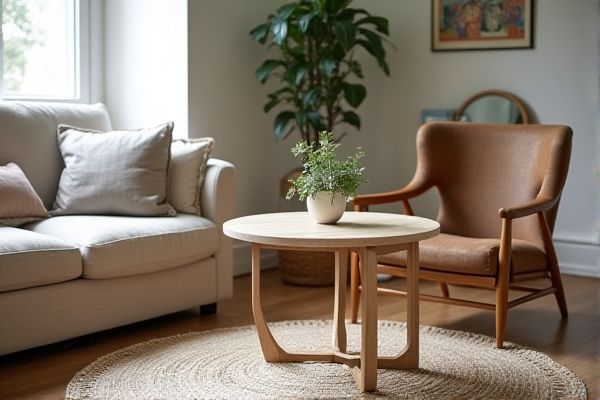
Nesting tables offer versatility and space-saving benefits by stacking multiple tables together, ideal for flexible living areas, while bistro tables provide a compact, stylish surface perfect for casual dining or small gatherings. Discover which choice best fits Your space and lifestyle in the rest of this article.
Table of Comparison
| Feature | Nesting Tables | Bistro Tables |
|---|---|---|
| Design | Stackable, multiple sizes fit under one another | Compact, round or square tops for casual dining |
| Space Efficiency | Highly space-saving due to nesting feature | Moderate; designed for small dining areas |
| Functionality | Versatile; used as side, coffee or occasional tables | Primarily for dining or cafe-style seating |
| Materials | Varies widely: wood, metal, glass | Commonly metal or wood, often weather-resistant |
| Portability | Lightweight and easy to move individually | Usually lightweight but less stackable |
| Common Uses | Living rooms, lounges, multipurpose spaces | Cafes, patios, small dining spaces |
Introduction to Nesting Tables and Bistro Tables
Nesting tables are versatile furniture pieces designed to fit neatly underneath one another, optimizing space while providing multiple surface options. Bistro tables, typically small and round, are crafted for casual dining or intimate settings, often found in cafes or small dining areas. Both serve functional purposes but cater to different spatial needs and aesthetic preferences in home or commercial environments.
Defining Nesting Tables: Features and Functions
Nesting tables are a set of compact, stackable tables designed to save space when not in use, featuring varying sizes that fit neatly under one another. Their primary function is versatility, serving as additional surfaces for drinks, books, or decorative items while easily stored to reduce clutter. Unlike bistro tables, which typically offer a single, fixed surface for dining or casual seating, nesting tables emphasize flexible multi-level use and optimized space management.
Understanding Bistro Tables: Style and Utility
Bistro tables offer a blend of classic style and practical utility, characterized by their compact design and often round tabletops that fit seamlessly in small spaces such as patios and cafes. Compared to nesting tables, bistro tables provide a stable, singular surface ideal for dining or coffee breaks, emphasizing aesthetic appeal with materials like wrought iron or wood. Your choice of a bistro table enhances outdoor or indoor ambiance while ensuring functional space use without the stacking feature typical of nesting tables.
Design Aesthetics: Visual Appeal Compared
Nesting tables offer a sleek, space-saving design with clean lines that enhance modern and minimalist interiors through their compact, stackable form. Bistro tables provide a classic, charming appeal with round or square tops often crafted from wood or metal, giving a cozy, inviting feel to dining or cafe settings. Your choice depends on whether you prefer the versatile, contemporary look of nesting tables or the timeless, intimate ambiance created by bistro tables.
Space-Saving Solutions: Which Table Wins?
Nesting tables offer superior space-saving solutions by stacking multiple tables compactly when not in use, making them ideal for small living areas or multifunctional rooms. Bistro tables, while charming and compact, occupy a fixed footprint that can limit flexibility in tight spaces. If maximizing your room's layout is a priority, nesting tables provide the ultimate convenience without sacrificing style or functionality.
Versatility in Usage: Flexibility for Different Spaces
Nesting tables offer exceptional versatility by allowing you to stack or separate them according to your space needs, making them ideal for compact living areas or dynamic room layouts. Bistro tables provide a fixed surface with a charming aesthetic, perfect for casual dining or cozy corners but less adaptable for varying functions or space constraints. Your choice between nesting and bistro tables depends on whether you prioritize flexible, space-saving options or a more stationary, decorative piece.
Ideal Settings: Best Environments for Each Table
Nesting tables offer versatility ideal for small living rooms, apartments, or compact spaces where flexible surface area is essential. Bistro tables excel in cafes, patios, and intimate dining areas, providing a charming setting for casual meals and socializing. The choice depends on space constraints and functional needs, with nesting tables maximizing space efficiency and bistro tables fostering cozy, elegant ambiance.
Material and Durability Comparison
Nesting tables typically feature engineered wood, metal frames, or MDF with veneer finishes, offering moderate durability suited for indoor use and easy storage. Bistro tables are often crafted from solid hardwood, metal, or weather-resistant materials like wrought iron and treated aluminum, ensuring higher durability ideal for both indoor and outdoor settings. Your choice should consider the material's resistance to wear, moisture, and stability based on the intended environment and usage frequency.
Price Points and Value for Money
Nesting tables typically offer better value for money due to their multi-functional design and space-saving convenience, with prices ranging from $50 to $200 depending on materials and brand. Bistro tables, often priced between $100 and $300, emphasize style and durability suited for small dining areas or cafes but may provide less versatility compared to nesting tables. Consumers prioritizing budget and adaptability tend to favor nesting tables, while those seeking aesthetic appeal and specific dining use often invest in bistro tables despite higher costs.
Choosing the Right Table for Your Home
Nesting tables offer versatile functionality with space-saving benefits, ideal for small living rooms or flexible seating arrangements. Bistro tables provide a cozy, stylish setting perfect for dining nooks or outdoor patios, emphasizing a more dedicated eating space. Selecting the right table depends on your home's spatial layout, usage needs, and design preferences.
 homyna.com
homyna.com